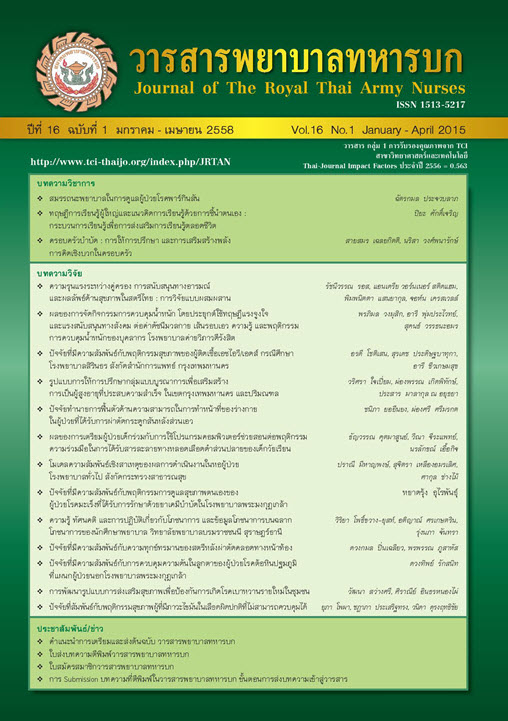ปัจจัยที่มีความสัมพันธ์กับความทุกข์ทรมานของสตรี หลังผ่าตัดคลอดทางหน้าท้อง Factors Related to Women’s Distress after Cesarean Section
Keywords:
ความทุกข์ทรมาน, สตรีหลังผ่าตัดคลอดทางหน้าท้อง, การผ่าตัดคลอดทางหน้าท้อง, Distress, Women after Cesarean Section, Cesarean SectionAbstract
การวิจัยครั้งนี้มีวัตถุประสงค์เพื่อศึกษาความทุกข์ทรมาน พฤติกรรมการเผชิญความเครียด และสัมพันธภาพของคู่สมรส ของสตรีหลังผ่าตัดคลอดทางหน้าท้อง และความสัมพันธ์ระหว่าง พฤติกรรมการเผชิญความเครียด สัมพันธภาพของคู่สมรส อายุ ระดับการศึกษา ลำดับที่ของการตั้งครรภ์ ชนิดของการผ่าตัด และประสบการณ์ผ่าตัดกับความทุกข์ทรมานของสตรีหลังผ่าตัดคลอด ทางหน้าท้อง กลุ่มตัวอย่างคือสตรีหลังผ่าตัดคลอดทางหน้าท้องจำนวน 260 คน เครื่องมือที่ใช้ในการวิจัยคือแบบสัมภาษณ์ความ ทุกข์ทรมานของสตรีหลังผ่าตัดคลอดทางหน้าท้อง แบบสอบถามพฤติกรรมการเผชิญความเครียด และสัมพันธภาพของคู่สมรส มีค่าความเที่ยงเท่ากับ 0.85 0.80 และ 0.85 ตามลำดับ วิเคราะห์ข้อมูลโดยแจกแจงความถี่ ร้อยละ ค่าเฉลี่ย ค่าเบี่ยงเบนมาตรฐาน สัมประสิทธิ์สหสัมพันธ์ของเพียร์สัน และไคว์-สแควร์ผลการศึกษาพบว่า (1) ความทุกข์ทรมานของสตรีหลังผ่าตัดคลอดทางหน้าท้องในระยะ 72 ชั่วโมง หลังผ่าตัดอยู่ในระดับ น้อย โดยสาเหตุที่ทำให้ทุกข์ทรมานด้านร่างกายมากที่สุด 3 อันดับแรก คือ ความเจ็บปวดขณะเคลื่อนไหวร่างกาย ความรุนแรงของ อาการปวดแผลผ่าตัด และอาการปวดแผลผ่าตัดที่เกิดขึ้นบ่อยครั้ง และมีความทุกข์ทรมานด้านจิตใจมากที่สุด 2 อันดับแรก คือ วิตกกังวลต่อสภาพความเจ็บป่วยของตนเอง และกิจกรรมการเลี้ยงดูบุตร สำหรับพฤติกรรมการเผชิญความเครียดและสัมพันธภาพ ของคู่สมรสอยู่ในระดับปานกลางและระดับดีตามลำดับ (2) พฤติกรรมการเผชิญความเครียด มีความสัมพันธ์ทางบวกในระดับต่ำกับ ความทุกข์ทรมานของสตรีหลังผ่าตัดคลอดทางหน้าท้อง อย่างมีนัยสำคัญทางสถิติที่ระดับ .05 (r = .138)
The objectives of this descriptive research were to study women’s distress after cesarean section, coping behaviors and marital relationship and the relationship between coping behaviors, age, education level, the number of pregnancy, type of cesarean section, operation’s experience and women’s distress after cesarean section. The samples were 260 women after cesarean section. The research instrument were 1) distress after cesarean section interview forms 2) coping behaviors and 3) marital relationship questionnaires. The reliability of the first to the third of instrument were 0.85, 0.80 and 0.85 respectively. The data were statistically analyzed in terms of frequency, percentage, means, standard deviation, Pearson product moment correlation coefficient and Chi-square.
The results of this study revealed as follows: (1) The women rated their distress during 72 hours after cesarean section at the low level. The three major causes of physiological’s distress were painful during moving body, severity of pain, frequency of pain respectively. The two major causes of psychological’s distress were anxiety about the illness and activities for child’s care. And the women rated their coping behaviors and marital relationship at the moderate and the high level. (2) There were statistically significant positive relationship between coping behaviors and women’s distress after cesarean section at the level of .05 (r = .138)
Downloads
How to Cite
Issue
Section
License
บทความหรือข้อคิดเห็นใดใดที่ปรากฏในวารสารพยาบาลทหารบกเป็นวรรณกรรมของผู้เขียน ซึ่งบรรณาธิการหรือสมาคมพยาบาลทหารบก ไม่จำเป็นต้องเห็นด้วย
บทความที่ได้รับการตีพิมพ์เป็นลิขสิทธิ์ของวารสารพยาบาลทหารบก
The ideas and opinions expressed in the Journal of The Royal Thai Army Nurses are those of the authors and not necessarily those
of the editor or Royal Thai Army Nurses Association.





